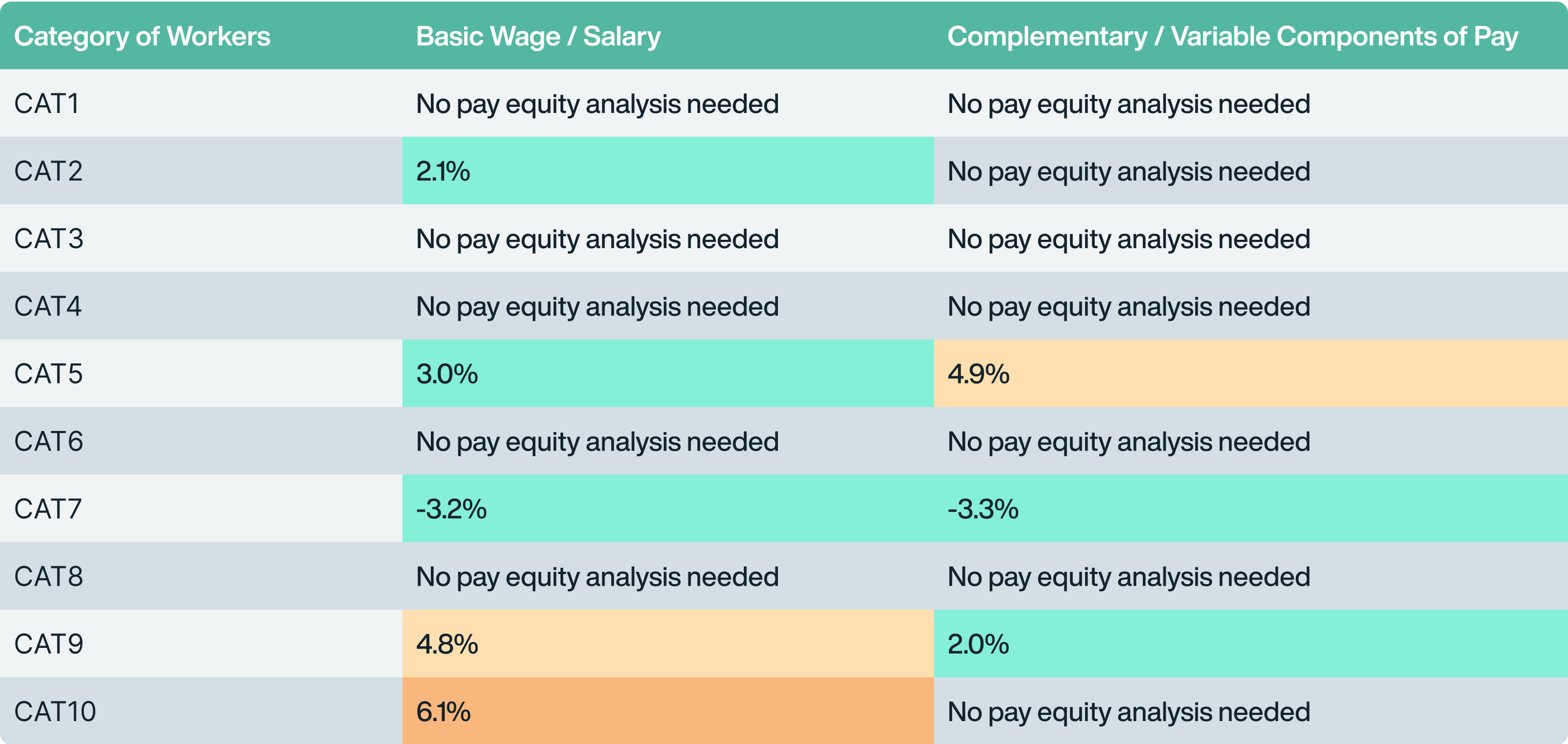As EU member states begin transposing the EU Pay Transparency Directive (EUPTD) into law, we thought it would be a good time to revisit the role of pay equity in the directive.
A key requirement is that covered employers report gender pay gaps by categories of workers — groups performing the same work or work of equal value. If the average pay gap between female and male workers in any category is 5% or more, the employer can justify it using objective, gender-neutral factors.
In such cases, we recommend conducting a pay equity analysis for any category showing a gap of 5% or more. If the gap persists even after accounting for objective, gender-neutral factors, we recommend implementing a remediation plan. Notably, if no action is taken, the EUPTD requires the employer to work with workers’ representatives to perform a joint pay assessment.
The figure below outlines a high-level process for evaluating pay gaps by worker category.

Now let’s delve into the logistics of this process more deeply.
Step 1. Compute Raw Pay Gaps Statistics for Each Worker Category
The first step is to calculate raw gender pay gaps — the difference in average pay between female and male workers — for each worker category. The EUPTD requires this for both (1) ordinary basic wage/salary and (2) complementary or variable pay, based on compensation from the previous calendar year.
If the raw pay gaps are below 5% for all categories under both pay measures, no further analysis is required, and results can be shared with workers’ representatives. However, if any category shows a gap of 5% or more under either measure, a pay equity analysis is recommended for those impacted categories.
The table below shows an illustrative example of raw gender pay gaps by worker category for both types of pay. Positive values indicate women earn less; negative values mean men earn less. Gaps of 5% or more (positive or negative) are highlighted in dark peach. A pay equity analysis is recommended for these cases. Gaps just under 5% are marked in light peach and may warrant a pay equity review. Gaps well below 5% are shown in mint green, requiring no further action.

Step 2. Conduct Pay Equity Analysis for Worker Categories with Gap of 5% or More
A key step in pay equity analysis is selecting compensable factors, which the EUPTD requires to be “objective” and “gender-neutral.” This starts with your organization’s compensation philosophy: what do you value and reward? For example, if you emphasize pay-for-performance, include performance as a factor. Common compensable factors also include company and position tenure, relevant prior experience, and geographic differentials (when pay varies by location).
Career level or job grade is often the biggest driver of pay differences. Whether to include it as a compensable factor depends on how worker categories are defined. If all workers in a category share the same career level, it need not be included. If categories span multiple career levels, it likely should be included.
If your pay equity analysis shows that gender pay gaps are below 5% in all worker categories for both basic and variable pay, no further action is needed, and the results can be shared with workers’ representatives. If any gap is 5% or more in any category for either pay type, a remediation plan must be developed and implemented for the impacted categories.
The table below is an illustrative example of unexplained gender pay gaps by worker category for both basic and variable pay. As in the earlier table, positive values mean women are paid less than men; negative values mean the opposite. Gaps of 5% or more (in either direction) are highlighted in dark peach, indicating that a remediation plan is recommended. Light peach highlights show gaps just below 5%, where remediation may be considered. Mint green indicates gaps well below 5%, and no further action is needed.

Step 3. Implement remediation plan for impacted worker categories
The EUPTD requires gender pay gap metrics to be based on ordinary basic wage/salary and complementary/variable pay from the previous calendar year — making the analysis inherently backward-looking. Since past compensation can’t be changed, remediation must take a forward-looking approach by adjusting current wages, salaries, or variable pay. Employers have six months from submitting the pay gap report to address gaps of 5% or more.
A remediation-focused pay equity analysis differs from the initial analysis by assessing current pay instead of past compensation. For example, if Step 2 reveals a 7% unexplained gap in 2024 basic wages for a worker category, remediation would involve reviewing current salaries in that category. If adjustments totaling €200,000 are needed to bring the gap below 5%, those changes should be implemented before sharing results with workers’ representatives.
Remediating variable pay is a bit more complex. While the Directive requires reporting a total figure for all variable components, effective remediation requires analyzing each component separately. Otherwise, it’s not possible to know which specific components are driving the gender pay gap and require remediation.
Our focus here has been on how to use a pay equity analysis to comply with the EU Pay Transparency Directive and avoid triggering a joint pay assessment. However, it’s important to emphasize that meeting the directive’s 5% pay gap threshold should not be viewed as the end goal. A strong, proactive pay equity strategy aims to eliminate unjustified pay disparities altogether — not merely to satisfy legal minimums.








